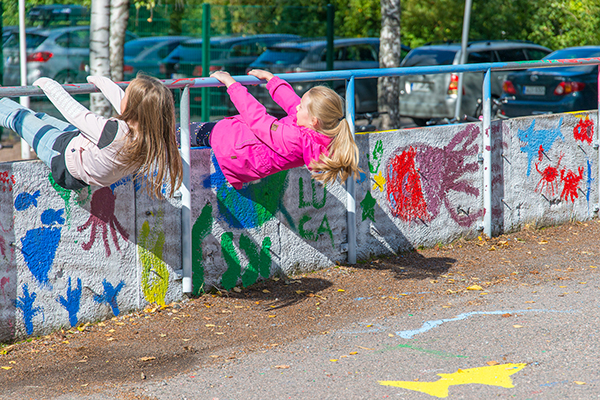Inactivity among children and young people is a growing global challenge, the solution to which consists of small everyday choices. To encourage these choices, the City of Helsinki has developed an operating model for its schools to promote schoolchildren’s physical and everyday activity. The model seeks to improve school travel safety to encourage an increasing number of pupils to walk or cycle to school daily.
A pilot project carried out at Suutarinkylä Comprehensive School sought to create an operating model for modifying the school’s courtyard and surrounding area, and thereby increase the appeal and safety of walking and cycling to school. The established operating model can be replicated in all Helsinki schools. Schools have the freedom to apply the measures set out in the model as they see fit, provided that the results support the City’s objective to increase the number of school trips by foot and bicycle.
The pilot project gave the children the opportunity to participate in planning the changes to their environment. At Suutarinkylä Comprehensive School, Töyrynummentie Street was converted into a living street with distinctive plantings and benches. The Schoolyard now features wooden “islets” and street paintings made with the schoolchildren. The number of frame-locking bike racks also increased.
“Involving the children in the planning of the school environment was an inspiring new way to consider the end-users in the design and, thereby, promote the attractiveness and safety of trips made by walking and cycling. The project’s effects on the perceived comfort of the immediate surroundings are encouraging. The level of ambition of similar future projects should be even higher, as it would further improve the outcomes. The next thing to do is to pick a new school!” says Oskari Kaupinmäki, Cycling Coordinator at the City of Helsinki, and the project manager.
Despite sports activities, the majority of children and young people get too little physical activity
The City of Helsinki finds it important to encourage children and young people to increase their everyday physical activity. This has been highlighted in Helsinki’s Physical Activity Programme, and it is a key part of the strategic objectives to ensure the vitality of the City.
“Besides sports activities, physical activity accrued during school trips, recesses and everyday errands or time together with friends and family is essential. In addition to health and well-being, it supports children and young people’s learning capabilities, coping in everyday life and mental well-being — not to mention the reduction of traffic emissions,” says Minna Paajanen, Project Manager of the City of Helsinki Physical Activity Programme.
Helsinki aims to improve the conditions for a physically active lifestyle as a means to improve the health of our citizens. Physical activity is to be incorporated into early childhood education, school and study days. Everyone is encouraged to engage in physical activity. Walking and cycling as modes of transport are also meant to be increased.
“The majority of Helsinki residents over the age of ten do not get enough physical exercise to stay healthy, even though most of the children and young people do engage in physical activity or sport. The world has very much changed in a direction that is less conducive to everyday physical activity in natural settings. As a strategic priority project, Helsinki’s Physical Activity Programme is going well. Incidental and everyday physical activity has been implemented in the City not only in words but also in 60 different actions,” says Minna Paajanen.
Operating model designed based on an international project
Suutarinkylä Comprehensive School was selected as the pilot school for the City of Helsinki’s collaboration with the Partnership for Healthy Cities. Supported by Bloomberg Philanthropies, the Partnership for Healthy Cities is a network of 70 cities worldwide, working together with the World Health Organization (WHO) and the global health organization Vital Strategies.
The cities of the network are committed to preventing non-communicable diseases, such as cancer and diabetes, through high-impact policy or programmatic interventions. Helsinki’s project aimed to promote the health and well-being of children and young people; by improving pedestrian and cycling conditions, we can also improve school travel safety.
Watch a video (in Finnish)
Final report (in Finnish)
Physical Activity Programme
Partnership for Healthy Cities network

